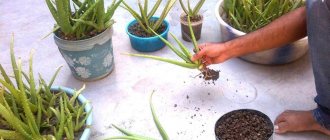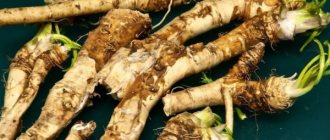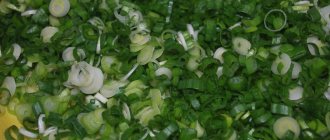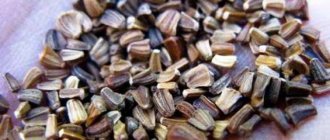Advantages and disadvantages of the method
Is it possible to plant an aloe plant without roots? It is quite possible to grow agave in this way, although this method is not widespread among gardeners.
The method has its positive sides:
- the plant will have all the varietal characteristics of its “parent”;
- the rooted leaf grows quickly and forms babies that can be used for propagation (read more about propagation by babies here);
- planting can be carried out at any time of the year.
On a note. But this method is very expensive in terms of time and effort. In addition, in only 30-40% of cases, aloe without roots takes root.
How to propagate aloe at home - the best time to do it
Each plant is characterized by periods of activity and dormancy. Aloe transplantation can be done at any time of the year, but spring and June are considered the best times. During such a period, the transplanted flower will quickly get used to the new soil and new conditions and begin to grow.
In warm weather, it is convenient to maintain the required temperature for a young flower.
Aloe propagation is a simple process.
Are there any chances of success?
While propagating and growing aloe from a rootless leaf is not an impossible task, the chances of it growing roots are very slim. The fact is that the leaves are saturated with moisture and tend to rot before their roots begin to form. You will find more nuances on how to grow aloe from a leaf in this article.
Soil requirements
Agave is unpretentious and grows even in arid areas, if we talk about the natural environment. However, at home it is important to take care of its comfortable living in the flowerpot. Well-loosened soil with large fragments, such as pieces of coal or coarse sand, ensures the free passage of moisture and fresh air to the root system.
In a specialty store you can purchase a mixture designed specifically for succulents. It will completely satisfy the needs of an indoor flower. When making your own turf, remember that the pH level should be slightly acidic or completely neutral. The soil is saturated with iron before planting the sprouts.
How to grow at home?
Now we’ll tell you step by step how to plant aloe without roots. The main methods here are as follows.
Place the leaf in water, then in soil
This method of growing aloe without roots is the most common. Let's look at how to grow a shoot from a leaf for subsequent planting. The following steps must be observed:
- Prepare a glass container for the leaf, pour settled water at room temperature into it and install the planting material.
- As soon as the roots appear, remove the leaf from the water and place it on a clean cloth.
- Leave the planting material in a warm place so that the film has time to form. This may take 2-3 days. The resulting film will protect the plant from soil infection.
- After this, you can transplant the plant into a prepared container with a drainage hole and 2/3 filled with substrate.
The planted shoot does not need to be heavily compacted with soil, and after planting it should be watered with settled water. Place in a dark place for 2-3 days.
What to do if a flower does not produce roots in water?
On the question of how to dissolve the roots of the agave in this case, the opinions of flower growers differ. Some say that cut leaves, if planted in water before planting in the ground, will certainly produce roots. Other flower growers are convinced that leaves rot when left in water for a long time, so it is better to plant them in the ground immediately. So the choice remains with the florist. In any case, if the method turns out to be ineffective, then the rapid reproduction of aloe will allow this procedure to be repeated without damage to the population.
Straight into the ground
This method is standard, and to implement it you must adhere to the following recommendations on how to grow roots:
- Cover the surface of the soil for planting with sand. It is better to use coarse grain, and its thickness should be approximately 2 cm.
- The fleshy leaf, dried for 2-3 days, is immersed in the ground with its lower part. The immersion height will be 2-3 cm.
- Using small leaves, cover the surface of the earth, pressing slightly.
- At first, watering should be replaced with banal spraying.
- After 8 weeks, when the first roots form, irrigation should be eliminated.
- As soon as the root system is developed, transplant the plant into soil intended for succulents.
- The surface of the ground can be sprinkled with a mixture of sand and expanded clay chips.
Features of aloe propagation
Aloe propagates indoors easily. After all, it is unpretentious, and attempts to breed it in 99% of cases end in success. Aloe, like many other succulents, is capable of propagation by the vegetative method, i.e. a part taken from one plant can be rooted and another flower can be grown from it.
Flower growers are familiar with several effective ways to propagate aloe indoors: leaves, children, cuttings, tops and seeds. Each of these methods has its own characteristics; even the most inexperienced gardener can propagate aloe.
Can it be placed in open ground?
You can transplant an aloe leaf into open ground, but only for the summer. If the spring in the region is warm and there are no frosts, then planting work should be carried out at the end of May.
It is important that the daytime temperature is 25-30 degrees, and the night temperature does not fall below 12 degrees.
Transplanting aloe into open ground is carried out as follows:
The first step is to choose a landing site. It should be carefully lit, but only direct sunlight is unacceptable.
- You also need to make sure that the aloe does not get wet during rain, otherwise it will rot.
- Once the location has been selected, you can dig a hole, the size of which will be slightly larger than the size and depth of the pot where the plant is located.
- Send sawdust or coal to the bottom, and sprinkle a layer of expanded clay on top. This layered “pie” is completed by a ready-made earthen mixture.
- Place the plant in the prepared hole and sprinkle with nutritious soil mixture.
Leaves
The least labor-intensive way to propagate agave at home is to propagate aloe leaves. First you need to carefully examine the leaves on the plant and choose the thickest and strongest of them. Such leaves are located at the bottom of the flower.
You should not choose leaves that have a yellowish or brownish tint. Those with stains on the surface are also not suitable.
These signs indicate that the leaf is unhealthy, and a damaged leaf will not grow into a strong plant. The selected leaf must be cut at its base as close to the stem as possible.
The cut leaf should be placed in a dark room and wait until the cut dries and a thin crust forms on it. As a rule, it takes no more than 3-5 days. When such a crust has appeared, you can move on to the next stage. You need to take 2-3 tablets of activated carbon, crush them into powder and sprinkle them on the cut area of the leaf. You can also use charcoal for this procedure. Immediately after this, you need to stick the leaf into the previously prepared soil so that the cut is underground at a depth of 3-5 cm.
An excellent soil for aloe will be soil with the addition of peat and sand. It is necessary to keep the soil moist at all times and not allow it to dry out. Well-moistened soil guarantees that young aloe will quickly take root and develop properly.
Aftercare
- Watering.
Aloe tolerates drought better than too much moisture. The plant is able to accumulate moisture in the leaves, so that it can remain without precipitation for some time. Young plants need to be watered once a week, and then the frequency of watering is reduced to once every 2-3 weeks. - Lighting.
Aloe fully develops only under conditions of intense lighting. It is better to place the flower pot on a south-facing window sill. If the plant does not receive light, its leaves will begin to grow unevenly and will become curved. - Temperature.
The flower grows actively at room temperature and can withstand a range of 12-30 degrees. In summer, pots can be placed outside or on the balcony. With the onset of winter, be sure to move them indoors. The frequency of watering will depend on the air temperature.Note! The warmer the room, the more water the flower will need.
We talked about other methods of propagating aloe in these articles:
- What are the secrets of growing aloe from seeds?
- Features of propagation of aloe by cuttings.
Selection and preparation of land
Aloe does not need too fertile soil . The substrate should be light and loose, water- and breathable. Acidity – weak or neutral.
The ideal option is special soil for succulents and cacti, which can be purchased at any gardening store. It contains enough nutrients necessary for the full development of young plants.
You can make a mixture according to the following recipe:
- turf soil - 2 parts;
- leaf soil - 1 part;
- coarse sand – 1 part;
- a small amount of ground charcoal;
- a few small stones.
Peat should not be added, as it increases the acidity of the substrate , which negatively affects the growth of aloe. Before planting, the soil must be exposed to high temperature - calcined in the oven at +90°C for 30 minutes.
Tip : At the bottom of the pot in which the young shoot will be planted, place drainage: medium-sized expanded clay, broken brick, small pebbles or shards. This will prevent moisture from stagnating in the container.
What to do if it doesn’t take root?
If the plant does not take root, the following recommendations will help solve this problem:
- Use soil from the forest for planting. It is the most nutritious for plants.
- Plant a leaf with roots in dry soil and do not water it for 7 days, and then pour water into the pan.
- Do not water aloe immediately after transplanting. Then it will take root faster, and if you fill it with water, there is a danger of the roots rotting.
Growing aloe from a leaf without roots is a difficult task, but quite doable if you try hard. Taking into account the recommendations presented, you can successfully propagate aloe leaves, saving personal time and effort. And under no circumstances should you worry if this procedure is not successful the first time, because you can always try again.
If you find an error, please select a piece of text and press Ctrl+Enter.
How to plant correctly?
The optimal time of year for planting aloe is early spring, when all the plant’s forces are concentrated on developing the root system. The frequency of transplants depends on the age of the agave:
- young plants are replanted annually;
- flowers 2-5 years old are transplanted into a new pot every 2 years;
- old aloe is replanted once every 3 years.
In order for the seedling to take root in a new place, you must follow the planting rules:
- Prepare a nutritious turf substrate.
- Spray the roots and above-ground parts of the seedling with Fitosporin.
- On the third day after transplanting, place the pot in a well-lit window.
- Do not water the plant for 7 days after transplantation, so as not to cause root rot.
- After 3-5 days, pour water into the pot tray.
- After two weeks, feed the agave with a weak solution of humus.
- Add wood ash infusion to water for irrigation.
Choosing soil and pot
The substrate for planting should be slightly acidic (pH in the range of 6.0-8.0), loose and nutritious. Optimal soil mixture recipe:
- 3 parts of turf;
- 1 part vermicompost;
- 1 part peat;
- 1 part sand.
To save time, you can buy a ready-made mixture “For succulents and cacti” in the store . It is also important to pay attention to the choice of pot. It should be wide enough (up to 30 cm) for unhindered root development, as well as stable and made of ceramic.
Preparing the appendage: how to take the baby?
The process of taking a shoot is carried out as follows:
- The soil in the pot is thoroughly moistened to soften it and make it more pliable.
- The plant is carefully removed from the pot and the maturity of the appendages is assessed.
- If they are sufficiently developed, they are separated from the rhizome using a garden trowel.
The most important thing when cutting off the “baby” is not to damage the root system of the mother plant.
How to transplant?
Algorithm for appendage transplantation:
- Wash the roots to remove soil residues.
- Treat them with a weak solution of potassium permanganate or hydrogen peroxide. This is necessary to prevent infectious diseases and root rot.
- Place the shoot on the drainage in the center of the pot - so that the base of the stem is 3 cm below the edge of the pot.
- Holding the stem, sprinkle the seedling with soil. The soil should be sifted first.
- Compact the soil and sprinkle with a thin layer of sand.
- Water generously at the root.
During the first 3 days, the plant must be protected from direct sunlight (to avoid burns).
Attention! In most cases, aloe infection occurs at the time of transplantation. Therefore, all operations must be performed with sterile gloves, the soil must first be steamed at a temperature of 60 ºС, and containers and equipment must be disinfected with a chloride solution.











